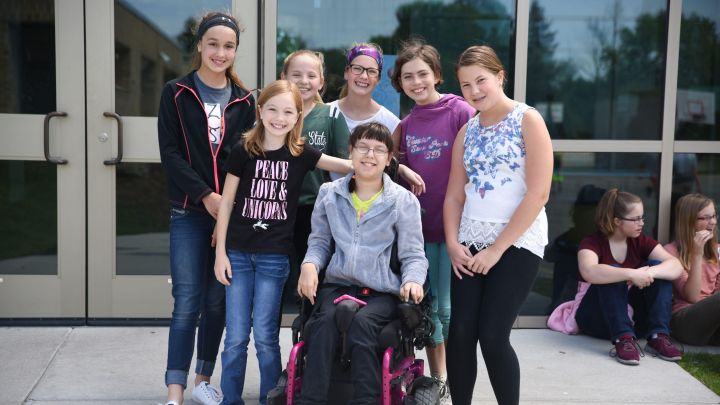Supporting Persons with Disabilities through the Holidays
A guide for parents, grandparents, and friends to use while supporting persons with disabilities through this season of celebration and change.
Note: Because this blog post was such a helpful resource for many individuals last holiday season, we wanted to share it with you again as you walk through the next few weeks of holiday festivities.
While the holidays often bring up those Hallmark memories for many of us, for some children and adults with disabilities, holidays signal an intense time of stress and distress. Often communicated with significant behavior changes, the underlying message might be “I’m overwhelmed”, “You changed my schedule”, “Why did you put a tree in our living room”, or “There are too many people stuffed into this room”, or “I am on complete sensory overload”. While all of these ideas won’t work for everyone, here are some ideas for you to try to create a positive time of celebration for each family member.
1. Who needs to know? Many times extended families get together, and yet cousins or friends may not really understand the individual with the disability. It might be helpful for parents or the person with the disability to send out a quick update to family members before an event. This update could include:
- “How Brent has grown this year”
- “Activities and topics Brent enjoys doing or discussing”
- “Activities and topics to avoid with Brent”
- “Some things that Brent may really enjoy when we gather for Christmas”
- “Some things that might be challenging for Brent at our Christmas celebration”
- “Some gifts Brent might enjoy receiving”
- “Some gifts to avoid"
2. "It is better to give than to receive” – and many times we think our family member with a disability should only be the recipient of gifts and not the giver. How can that person use an area of interest or gift to provide something for others? Would it be the gift of a dance or song? Could that individual provide the cookies for dessert? Might that person enjoy a trip to a dollar store to pick out something for each guest or family member? What about a wall decoration or a note card for each guest with a favorite picture of an animal or area of interest? Find a way for that individual to also receive the joy of giving.
3. Prepare in advance a way your family member can participate in the holiday traditions. Be creative. Think of ways you have made the holiday meaningful and consider ways your family member with a disability may be involved. Some ideas you could try include:
- Do you collect prayer requests or notes indicating things for which each family member is thankful to incorporate into the celebration? How might that family member participate? Would it be helpful to have pictures of familiar items so that the individual can point to or pick up the prayer request and hand it to the one praying?
- How about singing? Could you have a colorful streamer or small rhythm instrument available so that a person without words could participate in movement?
- How about programming a portion of Luke 2 on an iPad or other device so that pushing a button will allow an individual to read a portion of the Bible? Adding figures or using the manger scene on the mantel may be a way for an individual to better understand or even help move or tell the Christmas story.

Create a Christmas album! Photo Credit: Dolce_Evita
4. Use photos. Find some pictures of the celebration from last year. If it will be similar, put together a photo album or story of that event so that the individual can remember it in pictures and written words before attending a similar event this year.
5. Put together a schedule of events for your party. Whether in words and/or pictures, let the person know the planned order. Some individuals enjoy crossing off or removing the individual schedule items as they are completed.
I love using the Choiceworks app, as it's an amazing way to quickly turn an iPad or phone into a schedule. The app suggests the next activity and when the task is done, the user can sweep it to the "done" side of the board. In addition to the schedule board, there are also boards for feelings and waiting.
6. Visit the room ahead of time. Many times we redecorate or rearrange rooms to fit more people. Consider setting it up a day ahead and visiting that room without people in it. Let the individual explore the changes without the added stress of people. Perhaps leave something on a chair or in a certain place so that you can “reserve a spot” for the event when you arrive. The individual will know to find that space or item to make a more comfortable entry.
7. Give that individual a “job” to do. Perhaps they could be the photographer, back massager, coffee or beverage server, greeter (be the first to arrive and assimilate guests more slowly – often a better choice for some persons), or card distributor. Many times, a helping role will not only use the gifts of an individual, but it gives the person a clear sense of what to do in that environment.
8. Designate a “safe zone”. It might be helpful to show that family member a quiet and designated space in the home or building where there would be a calming and preferred activity. It might be a mini tramp, a rocking chair, a favorite book, or quiet classical music in a more isolated space where one might be able to find a refuge if the senses get overloaded.
Some other posts you might like:

Barbara J. Newman
Church and School Consultant
Barbara J. Newman (1962-2020) was the Director of Church Services at All Belong. For over 30 years, she endeavored to create communities of inclusion through All Belong. Co-administrating the inclusion program at Zeeland Christian School allowed her to stay on top of best practices which she shared at schools and churches nationwide and in her books and practical resources, including Autism and Your Church, Helping Kids Include Kids with Disabilities, the Inclusion Awareness Kit, Nuts & Bolts of Inclusive Education, and her latest title, Accessible Gospel, Inclusive Worship.
